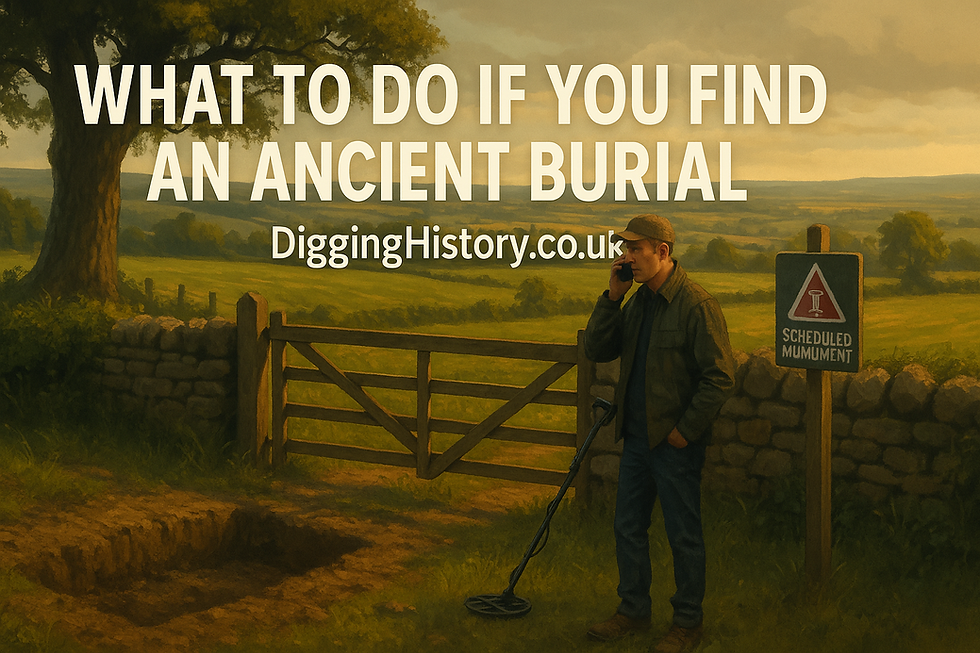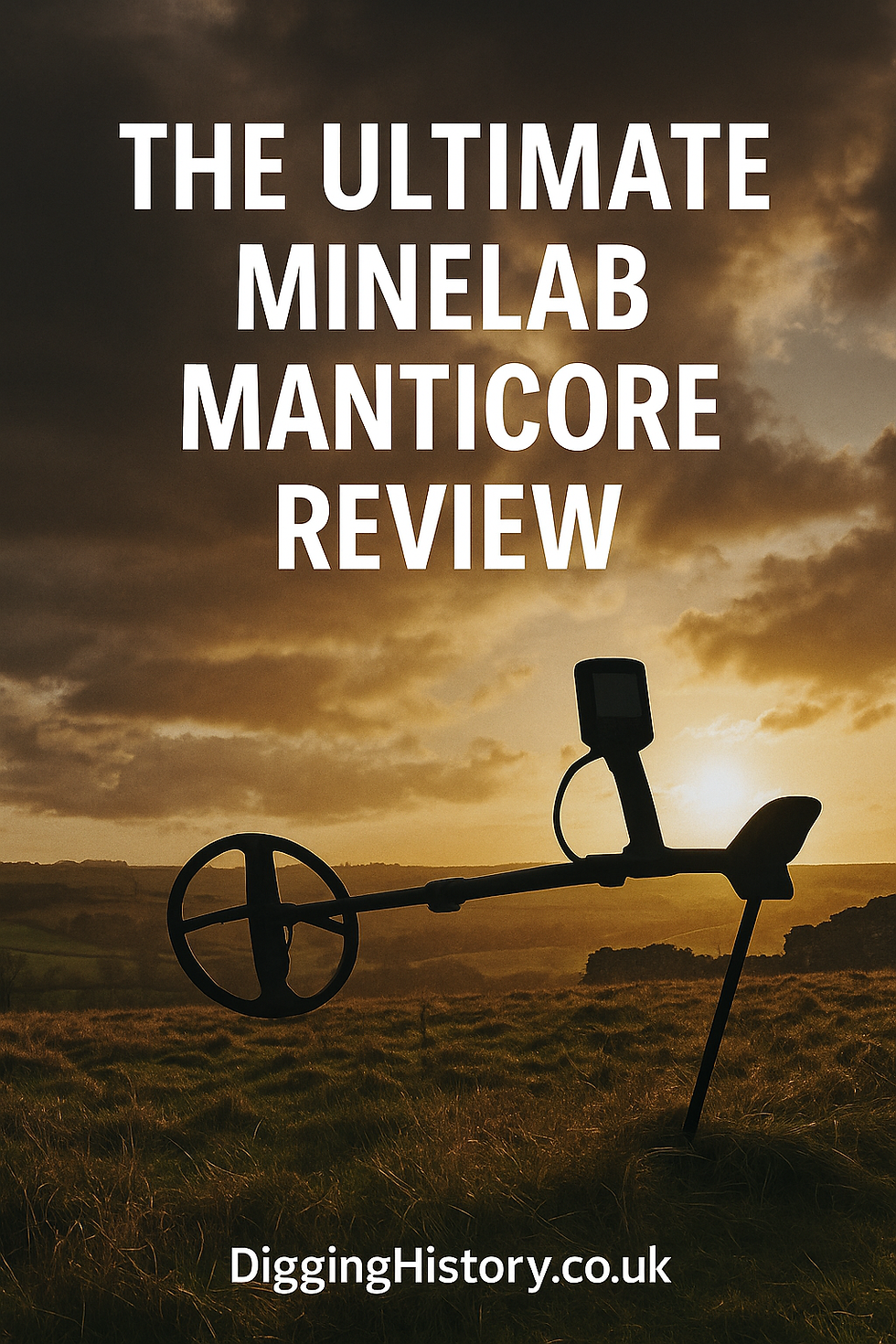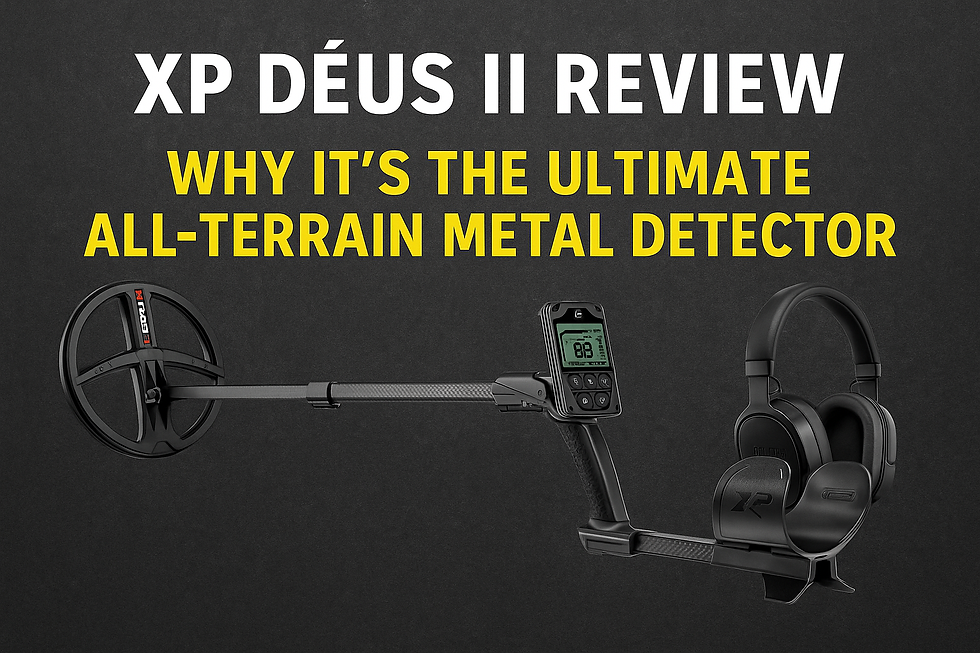Found An Ancient Burial Metal Detecting? What to Do (UK Guide)
- DiggingHistory.co.uk
- Sep 22
- 8 min read
Finding what appears to be a burial is one of the most serious and rare situations you can encounter with a detector. It’s also one where doing the right thing immediately protects the site, respects the dead, and keeps you on the right side of the law.
This guide covers:
Immediate actions at the findspot
Who to call (by nation) and what to say
What the law says (England & Wales, Scotland, Northern Ireland)
What not to do, common mistakes that cause real harm
Recording, reporting and aftercare
FAQs and a printable checklist you can keep in your bag

First 15 Minutes: Step-by-Step
1) Stop immediately and step back
If you see bone, a grave cut, a coffin fitting, or a concentration of artefacts that looks like a burial context, stop detecting and digging right away. Human remains, even very old ones, are governed by strict legal and ethical rules. finds.org.uk
2) Call the police from the spot
England & Wales: Call 101 (or 999 if you can see bones or there’s immediate risk). Police will assess and, if it’s not a recent death, will liaise with the Coroner and relevant heritage officers. GOV.UK
Scotland: Call Police Scotland. Police will consult the Procurator Fiscal and may involve the local council archaeologist/Historic Environment Scotland if the burial appears ancient. historicenvironment.scot
Northern Ireland: Call PSNI. Police can coordinate with the Coroners Service and Historic Environment Division (DfC) as needed. nidirect
3) Record essentials—without disturbing anything
Note the GPS coordinates, time, and who is present.
Take two or three wide-angle photographs from a safe distance for context (no close-ups of remains).
Protect the area from trampling; if possible, place a few sticks/flags away from the visible features so responders can find it.
4) Notify the landowner/occupier
You must keep them in the loop, explain you have paused work and the police/authorities are being contacted (or already notified).
5) Keep the location confidential
Don’t share coordinates publicly or in group chats. Heritage crime and looting are real risks; undermining site security can also jeopardise investigations. Historic England
Who You Should Contact and Why (Nation-by-Nation)
England & Wales
Police first. They will coordinate with the Coroner if remains are suspected/confirmed. Disturbance of human remains is tightly controlled. GOV.UK
Portable Antiquities Scheme (PAS) / your Finds Liaison Officer (FLO) for non-human-remains finds or after the police/coroner give the all-clear. If any associated objects might be Treasure, there’s a 14-day legal reporting limit (see “Treasure” section). GOV.UK
If the area is a scheduled monument, metal detecting is controlled by Section 42 of the Ancient Monuments and Archaeological Areas Act 1979—using a detector or removing objects on a protected place without written consent is a criminal offence. Legislation.gov.uk
Scotland
Police Scotland first; they can involve the Procurator Fiscal and local archaeologists. Official advice is do not touch remains and avoid disturbing the surrounding area. historicenvironment.scot
Treasure Trove: all significant finds must be reported to Treasure Trove Unit (TTU). This is separate from the police’s handling of human remains. Treasure Trove
Scheduled monuments have strict legal protections; unauthorised works (including detecting on scheduled sites) are offences. historicenvironment.scot
Northern Ireland
PSNI first; they can coordinate with the Coroners Service and DfC Historic Environment Division. nidirect
It is an offence to search for archaeological objects that involves disturbing the ground without a licence from DfC (this is broader than GB law), and it’s an offence even to possess a detecting device on a protected site. nidirect
The Law in Plain English (and Why It Matters)
Disturbing human remains is tightly controlled
In England & Wales, removing or disturbing human remains typically requires lawful authority; disturbing burials without proper permission can be an offence. Archaeological removals, where permitted, operate under specific licences or consents (e.g., via the Ministry of Justice for exhumation in certain contexts, or ecclesiastical faculty for consecrated ground). You should never attempt removal yourself. honour.org.uk
In Scotland, police and the Procurator Fiscal will determine next steps if remains are discovered; the standing guidance is to leave in situ and report immediately. historicenvironment.scot
In Northern Ireland, the rules around searching and protected places are stricter than GB; unauthorised searching, or possession of a detecting device at a scheduled/state care monument, is an offence. nidirect
Detecting on scheduled monuments is a criminal offence without consent
Across the UK, using a detector on a scheduled monument (a “protected place”) without written consent is a criminal offence; removing any object found by a detector from a protected place without consent is also an offence. Don’t detect on scheduled sites. Check mapping and designations before you go. Legislation.gov.uk
“Treasure”: the 14-day rule (England, Wales, NI)
If your burial find also includes items that might be Treasure, you must report within 14 days of discovery or realising it might be Treasure. Your FLO can help, and the Coroner will ultimately decide whether an object is Treasure. (Scotland uses Treasure Trove; see below.) finds.org.uk
Scotland’s Treasure Trove system
In Scotland, all significant portable antiquities must be reported to Treasure Trove (Crown claim), separate from the police involvement around any human remains. Treasure Trove
How to Recognise a Potential Burial
Look for any of the following and stop if you see them:
Curved or straight bone fragments in situ
A defined grave cut (softer, different-coloured soil in an elongated oval)
Coffin fittings: nails in a rectangle, decorative handles/escutcheons
Clusters of personal items (e.g., buckles) aligned with a body outline
Stones arranged like a cist or grave lining
If in doubt, treat it as a burial until told otherwise by the authorities. The PAS Code of Practice for Responsible Metal Detecting explicitly advises calling the police if you find any trace of human remains or a likely burial. finds.org.uk
What Not to Do (Even with Good Intentions)
Don’t dig further “to be sure.” Subtle context is vital evidence, both archaeological and forensic.
Don’t bag any bones or grave goods. You may commit an offence and you’ll contaminate the context.
Don’t post photos/coordinates online. You could trigger looting and compromise investigations. Historic England
Don’t assume “very old = low risk.” Age isn’t obvious at first glance; the police/Coroner or Procurator Fiscal must assess. GOV.UK
After You’ve Reported: What Happens Next?
Police attendance / assessment: They’ll secure the scene and determine whether it’s modern, historic, or of forensic interest. If ancient, they’ll liaise with the Coroner (England & Wales, NI) or Procurator Fiscal (Scotland) and local archaeologists. GOV.UK
Archaeological response: Where appropriate, local authority archaeologists/Historic England/Historic Environment Scotland/NI HED will advise next steps. Human remains on archaeological sites are subject to specialist guidance and ethical standards. Historic England
Treasure / Treasure Trove route: If associated objects meet the test for Treasure (E/W/NI) or are claimable under Treasure Trove (Scotland), the usual processes and timelines apply. GOV.UK
Special Locations and Permissions (Know Before You Go)
Scheduled monuments & protected places: Don’t detect. Section 42 consent is needed even for surveys; using a detector or removing objects without consent is an offence. Historic England
Northern Ireland: You generally need a licence to search for archaeological objects at all if ground is disturbed, and you must not even possess a detector on protected sites. nidirect
Burial grounds and consecrated land: Separate rules apply; do not disturb anything and contact authorities. (In England & Wales, exhumation typically requires authority, don’t act on your own.) honour.org.uk
Recording Finds (When It’s Appropriate to Do So)
Outside a burial context and only once authorities confirm it’s safe/legal to proceed, recording small, unrelated surface finds is good practice. The Portable Antiquities Scheme offers conservation advice and encourages voluntary recording to add to the archaeological record. finds.org.uk
Find your local FLO: https://finds.org.uk/contacts
Report Treasure (E/W/NI): https://www.gov.uk/treasure (step-by-step) GOV.UK
Treasure Trove (Scotland): https://treasuretrovescotland.co.uk (Information for Finders) Treasure Trove
Heritage Crime: Why Discretion Matters
Sharing precise locations can lead to nighthawking and damage. Historic England’s enforcement pages and guidance for officers make clear that damaging scheduled monuments, using a detector on them, or removing objects without consent are criminal offences. Keep details secure and cooperate with the authorities. Historic England
Found An Ancient Burial Metal Detecting FAQs
I only saw a small bit of bone. What if it’s animal?
You can’t be certain on sight. Treat all bone as human until told otherwise, and call the police. Better a cautious report than an offence or destroyed evidence. historicenvironment.scot
I found old metal items near the suspected burial. Should I bag them to keep them safe?
No. Leave everything in place. If the items could be Treasure, mention this when you call; the 14-day reporting rule can run from when you realise it might be Treasure, but do not move it yourself from a burial context. GOV.UK
Does this apply if I’m underwater or on the foreshore?
Yes. Additional rules apply to wreck and the Receiver of Wreck (E/W/NI). Scotland still uses Treasure Trove for portable antiquities; report significant finds to TTU. GOV.UK
Can I ever detect on a scheduled monument with permission?
In practice, no for hobby detecting. Section 42 consent is required for any detector use on a protected place; it’s a criminal offence without written consent. Archaeological teams sometimes operate under formal consents for specific research, but that’s not casual detecting. Historic England
I’m in Northern Ireland, are the rules really different?
Yes. NI law is stricter: you need a licence to search for archaeological objects where ground is disturbed, and even possession of a detector on a protected site is an offence. nidirect
Useful Links (Official Guidance & Contacts)
Code of Practice for Responsible Metal Detecting (PAS) – highlights human remains protocol and good practice: https://finds.org.uk/getinvolved/guides/codeofpractice finds.org.uk
Report Treasure (England & Wales step-by-step): https://www.gov.uk/treasure and step-by-step: https://www.gov.uk/report-treasure-step-by-step GOV.UK
Treasure overview (PAS & British Museum): https://finds.org.uk/treasure / https://www.britishmuseum.org/our-work/national/treasure-and-portable-antiquities-scheme finds.org.uk
Historic Environment Scotland – If you discover human remains: https://www.historicenvironment.scot
Northern Ireland – Archaeology & treasure: https://www.nidirect.gov.uk/articles/archaeology-and-treasure (what to do, 14-day rule locally) nidirect
Section 42 (Ancient Monuments & Archaeological Areas Act 1979) – restrictions on metal detecting in protected places: https://www.legislation.gov.uk/ukpga/1979/46/section/42 and Historic England guidance: https://historicengland.org.uk/advice/planning/consents/section42-consent/ Legislation.gov.uk
Respect, Ethics and Good Detectorist Practice
The UK approach balances public interest, scientific value and respect for the dead:
Respect the deceased: human remains are not “finds.” They belong to a person, family and culture.
Protect the story: context is everything. Unwitting disturbance destroys information forever.
Work with the system: police, coroners/Procurator Fiscal and heritage officers ensure legal, safe, respectful handling.
Historic England provides specialist human-remains advice for archaeological sites in England; professionals follow strict standards. Your role is to do no harm, call it in, and help secure the area. Historic England
Example Script (What to Say on the Phone)
“Hello, I’m metal detecting on private land with permission near [nearest road/postcode]. I’ve stopped because I think I’ve found a burial, there appears to be [brief description]. I haven’t touched or moved anything. I can meet an officer at the field gate by [landmark]. My phone number is [number].”
Final Word
If you think you’ve found an ancient burial metal detecting, the best detectorist practice is simple: stop, call, protect, and respect. You’re not “giving up a find”, you’re doing the right thing by the person buried there and by the law, and you’re preserving a once-in-a-lifetime site for proper investigation.
About the Author / Page (DiggingHistory.co.uk)
This guide is intended for UK hobby detectorists who want to detect responsibly and legally. For more on good practice, see the PAS Code of Practice and our UK-nation legal primers linked above. finds.org.uk
Sources & Key References
PAS Code of Practice (human remains: call police; do not disturb). finds.org.uk
Historic Environment Scotland: If you discover human remains, inform the police; do not touch. historicenvironment.scot
Northern Ireland: licensing & reporting rules; offence to search by disturbing ground; detector possession on protected sites. nidirect
Ancient Monuments & Archaeological Areas Act 1979, Section 42: offences re. detecting in protected places. Legislation.gov.uk
Historic England Section 42 overview (consent & offences). Historic England
Historic England Heritage Crime guidance (why secrecy matters). Historic England
Historic England Human Remains advice (specialist guidance exists for archaeology). Historic England
Thanks for reading! If you found this guide useful, please share it with your detecting club, landowners, and friends. It really helps more people detect responsibly and protect our heritage.
Want more practical, UK-specific tips? Explore our latest guides on DiggingHistory.co.uk and don’t forget to bookmark the site for future reference.





Comments